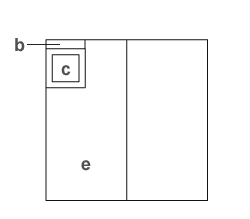1 The
small strip of red pine that is inserted between the end of the firebox
and the rear wall, or between the fire box and a wooden floored alcove
*tokonoma 床の間. The
ko-ita is 6.0 to 6.6cm wide with the length equaling the width of
the hearth position at the right inner edge of the host's mat *mukougiri
向切, or in a corner arrangement *sumiro
隅炉. When the hearth is cut into a smaller sized mat *daimedatami
台目畳, a wide board of straight grain cedar *mukou-ita
向板, the width of the mat, is placed between the end of the mat, the wall,
or another mat. Even in this case, a small, narrow ko-ita, 5.4cm wide
is inserted between the wide board and the edge of the hearth. Example:
Masudoko-no-seki 枡床席 in Daitokuji Jukouin 大徳寺聚光院, Kyoto.
2 A board, often lacquered, placed under a portable stove *furo
風炉. If the stove is made of iron, it is placed on a paving tile *shikigawara
敷瓦 of Oribe 織部 pottery, Bizen 備前 pottery, or porcelain jiki 磁器.
The standard size is 30cm square and 3cm thick. |




